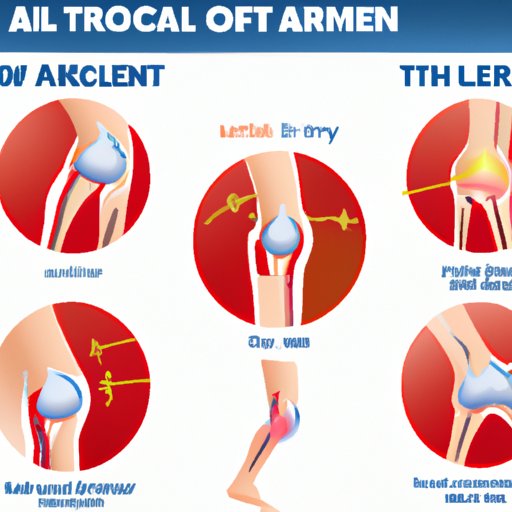
I. Introduction
An ACL or anterior cruciate ligament is one of the four main ligaments in the knee that connect the femur to the tibia bone. A torn ACL is a common knee injury that can occur as a result of quick, sudden movements, or blunt force to the knee. Notably, athletes who engage in high-intensity sports are at a higher risk of this injury. Knowing the symptoms, risk factors, diagnosis, treatment options, recovery process, and preventive measures can help individuals better manage the injury and prevent complications.
II. Symptoms and Signs
An ACL tear is a severe knee injury that causes sudden pain and symptoms that can vary in intensity. Common signs and symptoms of an ACL tear include swelling, instability, and pain. The knee may also give out or pop with movement. If a person experiences any of these symptoms, he or she may suspect an ACL injury.
The swelling may occur gradually after the injury, or it may occur suddenly during the activity. The instability sensation can cause a person to feel that the knee is giving out or shifting, which can make it challenging to bear weight. Finally, the pain can range from mild to severe, and it may increase with activity. If a person suspects an ACL tear, he or she should seek medical attention.
III. Risk Factors
Some factors may increase the odds of an ACL tear, including age, gender, and sports. Females and individuals over the age of 40 are more prone to this injury. Additionally, certain high-intensity sports like basketball, football, soccer, and skiing may increase the risk of ACL tear.
However, it is possible to reduce the risk of ACL tear. Exercise programs that emphasize proper technique, plyometrics, and strength training can help protect the knee. Wearing protective equipment such as knee pads, braces, or helmets can also reduce the risk of injury.
IV. Diagnosis
Several diagnostic tests and exams may be used to confirm a suspected ACL tear. These include a physical examination, MRI, X-rays, CT scan, and ultrasound. Your doctor may use one or more of these diagnostic tests to determine the severity of the injury.
During a physical examination, your doctor may ask questions about your symptoms, weight-bearing ability, and medical history. He or she may also examine and maneuver your knee to determine any pain, swelling, or instability. An MRI uses magnetic fields and radio waves to generate detailed images of the knee’s internal structures, while X-rays are useful for identifying bone fractures.
V. Treatment Options
The treatment plan for an ACL tear varies based on the severity of the injury, age of the patient, and the patient’s activity level. However, the primary goals of treatment are pain management, healing, and restoring joint mobility. Treatment options for an ACL tear may include surgery or non-surgical intervention, depending on the severity of the injury.
For mild or partial tears, non-invasive approaches like physical therapy, exercises, and other forms of rehabilitation may be recommended to restore knee function and achieve pain relief. Moreover, the use of cryotherapy, or the application of cold to the affected area, may also help reduce inflammation and pain.
If the ACL tear is severe or complete, surgery may be the recommended course of action. During ACL surgery, the surgeon will either repair or reconstruct the damaged ligament. In most cases, patients undergo rehabilitation therapy combined with surgery to help regain range of motion and prevent further injury.
VI. Recovery
The recovery process for an ACL tear can be lengthy and intensive, involving a series of rehabilitation exercises that aim to improve the knee function and strength. After surgery or non-surgical intervention, the recovery process typically starts with rest, ice, compression, and elevation (RICE) of the knee. Your doctor may also prescribe pain medication to alleviate any discomfort.
Physical therapy is also a crucial aspect of recovery after an ACL tear. Your therapist may recommend exercises aimed at improving knee stability and range of motion, as well as bracing and activity modification. Patients should follow the rehabilitation program diligently, as failure to do so could lead to complications or reinjury.
VII. Preventive Measures
Several steps can be taken to prevent an ACL tear, including proper training techniques, wearing protective gear, warming up before activity, and strengthening the muscles around the knee. For example, exercises like squats, lunges, and leg presses can help build leg strength, promoting knee stability. It is also essential to wear the right footwear and to avoid playing or exercising on uneven surfaces.
VIII. Complications
Without proper treatment, an untreated or improperly treated ACL tear can have several potential complications. Patients may experience chronic pain, knee instability, or development of arthritis. In rare cases, re-injury to the ACL or other ligaments may occur. It is essential to remain vigilant of complications and to consult your doctor if you experience any unusual symptoms or discomfort.
IX. Conclusion
In conclusion, an ACL tear can be a painful and life-altering injury. However, by knowing the signs and symptoms, risk factors, diagnosis, treatment options, recovery process, preventive measures, and potential complications, patients can better manage their knee injury. Patients should consult a physician if they suspect a knee injury, follow the recommended treatment plan, and incorporate preventive measures to reduce the risk of future injury. By doing so, individuals with an ACL tear can recover and regain their mobility.




